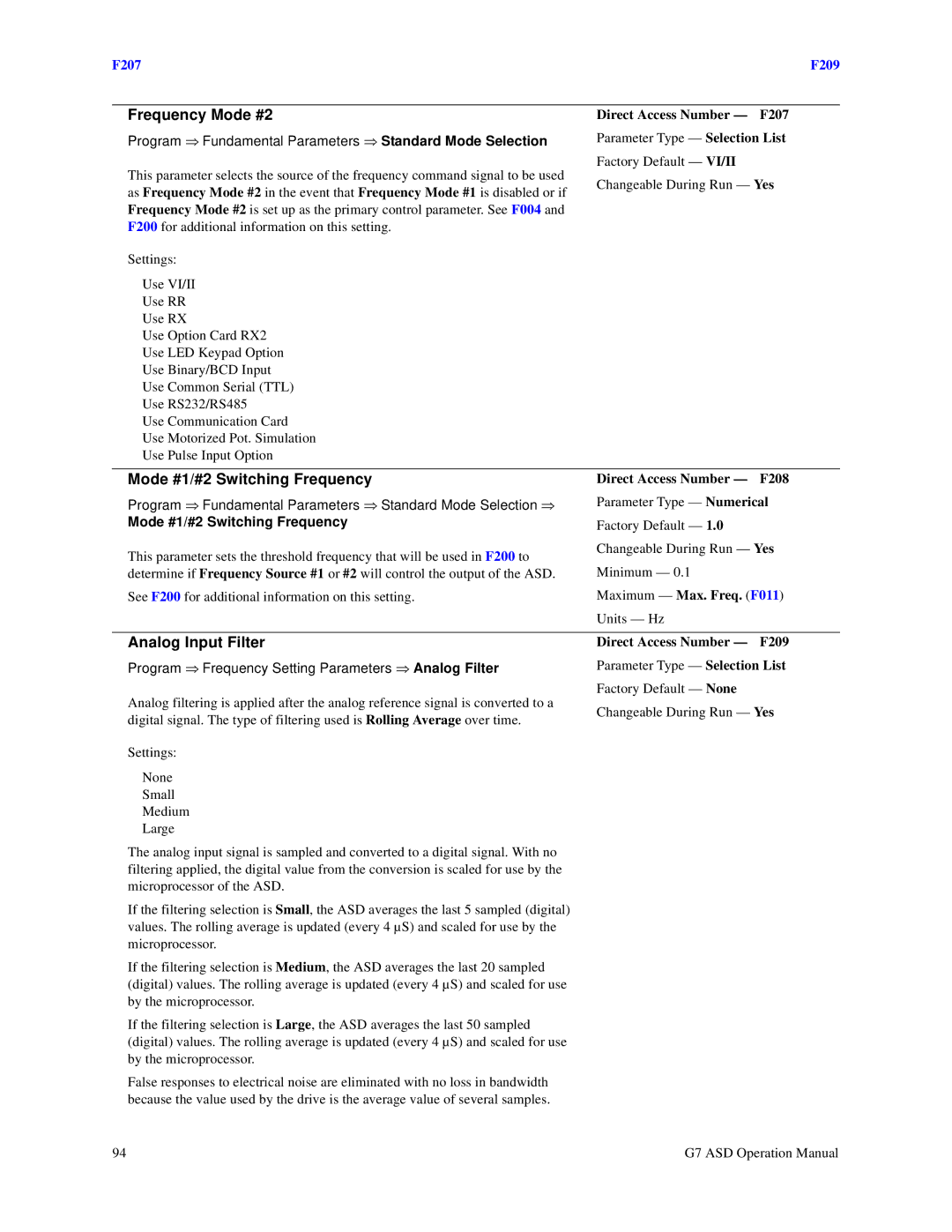F207 | F209 | |
|
| |
Frequency Mode #2 | Direct Access Number — F207 | |
Program ⇒ Fundamental Parameters ⇒ Standard Mode Selection | Parameter Type — Selection List | |
This parameter selects the source of the frequency command signal to be used | Factory Default — VI/II | |
Changeable During Run — Yes | ||
as Frequency Mode #2 in the event that Frequency Mode #1 is disabled or if | ||
| ||
Frequency Mode #2 is set up as the primary control parameter. See F004 and |
| |
F200 for additional information on this setting. |
| |
Settings: |
| |
Use VI/II |
| |
Use RR |
| |
Use RX |
| |
Use Option Card RX2 |
| |
Use LED Keypad Option |
| |
Use Binary/BCD Input |
| |
Use Common Serial (TTL) |
| |
Use RS232/RS485 |
| |
Use Communication Card |
| |
Use Motorized Pot. Simulation |
| |
Use Pulse Input Option |
| |
|
| |
Mode #1/#2 Switching Frequency | Direct Access Number — F208 | |
Program ⇒ Fundamental Parameters ⇒ Standard Mode Selection ⇒ | Parameter Type — Numerical | |
Mode #1/#2 Switching Frequency | Factory Default — 1.0 | |
This parameter sets the threshold frequency that will be used in F200 to | Changeable During Run — Yes | |
| ||
determine if Frequency Source #1 or #2 will control the output of the ASD. | Minimum — 0.1 | |
See F200 for additional information on this setting. | Maximum — Max. Freq. (F011) | |
| Units — Hz |
Analog Input Filter
Program ⇒ Frequency Setting Parameters ⇒ Analog Filter
Analog filtering is applied after the analog reference signal is converted to a digital signal. The type of filtering used is Rolling Average over time.
Settings:
None
Small
Medium
Large
Direct Access Number — F209
Parameter Type — Selection List
Factory Default — None
Changeable During Run — Yes
The analog input signal is sampled and converted to a digital signal. With no filtering applied, the digital value from the conversion is scaled for use by the microprocessor of the ASD.
If the filtering selection is Small, the ASD averages the last 5 sampled (digital) values. The rolling average is updated (every 4 µS) and scaled for use by the microprocessor.
If the filtering selection is Medium, the ASD averages the last 20 sampled (digital) values. The rolling average is updated (every 4 µS) and scaled for use by the microprocessor.
If the filtering selection is Large, the ASD averages the last 50 sampled (digital) values. The rolling average is updated (every 4 µS) and scaled for use by the microprocessor.
False responses to electrical noise are eliminated with no loss in bandwidth because the value used by the drive is the average value of several samples.
94 | G7 ASD Operation Manual |
